Lark Surname Ancestry ResultsOur indexes 1000-1999 include entries for the spelling 'lark'. In the period you have requested, we have the following 122 records (displaying 101 to 110): Single Surname Subscription | | | Buying all 122 results of this search individually would cost £710.00. But you can have free access to all 122 records for a year, to view, to save and print, for £100. Save £610.00. More... |
These sample scans are from the original record. You will get scans of the full pages or articles where the surname you searched for has been found. Your web browser may prevent the sample windows from opening; in this case please change your browser settings to allow pop-up windows from this site. Officers of the Royal Navy
(1904)
The Monthly Naval List for November 1904, printed By Authority for the Admiralty, contains this Alphabetical List of the Officers on the Active List of the Royal Navy and the Royal Marines with the Dates of their Seniority. The first column 'Where serving' gives the number of the ship; the second column gives full name, surname first, but with middle names represented only by initials; the third column rank; and the fourth column seniority, i. e., the date of attaining that rank. Lieutenants whose seniorities are printed in italics are on the Supplementary List, and Engineer Lieutenants whose seniorities are printed are those not yet advanced.LARK. Cost: £4.00.  | Sample scan, click to enlarge
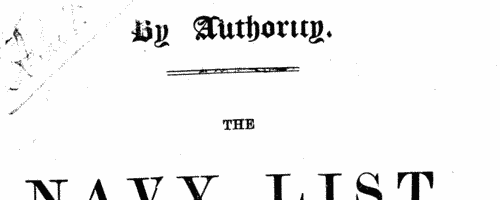
| Paymasters-in-Chief of the Royal Navy
(1904)
The Monthly Naval List for November 1904, printed By Authority for the Admiralty, contains this List of Officers on the Active List of the Royal Navy with the Dates of their Seniority. The list is arranged by rank, and then by date of seniority: full names, including full middle names, are given. Each name is preceded (where appropriate) by the number of the ship in which serving; an 'm' indicating the holder was entitled to wear a medal; one or more asterisks for officers authorized to hold foreign orders. (C) after the name denotes an officer who had obtained his lieutenant's commission by competition at the Royal Naval College; (E) one who had obtained the same for meritorious examination there; or (G) one who had received an honorary certificate or had qualified as a Gunnery or Torpedo Lieutenant. There are also various sets of initials in italics indicating: AdC Aide-de-Camp to the King, AO Clerk to Secretary to a Flag Officer, CG Coast Guard, CGP Coast Guard Pension, Coll studying at Naval College, Dev an acting sub-lieutenant studying at Devonport, DY Dock Yard, GH Greenwich Hospital, GHP Greenwich Hospital Pension, GSP Good Service Pension, KHC Honorary Chaplain to the King, KHP Honorary Physician to the King, KHS Honorary Surgeon to the King, NH Naval Hospital, NID Naval Intelligence Department, NP Naval Pension, Po an acting sub-lieutenant studying at Portsmouth, PW Pension for Wounds, RNVR Royal Naval Volunteer Reserve, SC undergoing short course of instruction in torpedo, gunnery, &c., ScM Royal Naval School of Music, Sec Secretary to a Flag Officer, TB Torpedo Boat, TP Travers Pension, TS Transport Service, VY Victualling Yard. Large or bold letters in brackets or circles indicate qualifications in - G gunnery, I interpreting, N navigating, S secretary, T torpedo. There are lists for Flag Officers (Admirals of the Fleet, Admirals, Vice-Admirals, and Rear Admirals); Captains; Commanders; Lieutenants; Supplementary Lieutenants; Sub-Lieutenants (with class of their certificates in seamanship, navigation, pilotage, gunnery and torpedo); Midshipmen; Navy Cadets; Staff Captains; Engineer Rear-Admirals; Engineer Captains; Engineer Commanders; Engineer Lieutenants; Engineer Sub-Lieutenants; Chaplains (where these also acted as Naval Instructors, their seniority in that appointment is given as well); Naval Instructors (where these also acted as Chaplains, their seniority in that appointment is given as well); (Medical) Inspector-Generals of Hospitals and Fleets; Fleet Surgeons; Staff Surgeons; Surgeons; Paymasters-in-Chief; Fleet Paymasters; Staff Paymasters; Paymasters; Assistant Paymasters; Clerks; Assistant Clerks; Carpenter Lieutenants; Chief Gunners; Gunners; Chief Boatswains; Boatswains; Chief Signal Boatswains; Signal Boatswains; Chief Carpenters; Carpenters; Chief Artificer Engineers; Artificer Engineers; Chief Schoolmasters; Head Schoolmasters; Head Wardmasters.LARK. Cost: £4.00.  | Sample scan, click to enlarge
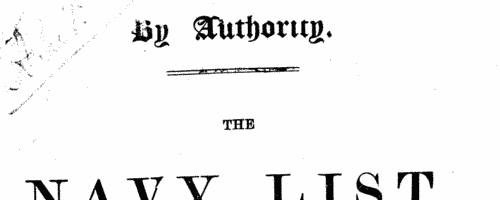
|  Queen's South Africa Medal: Royal Field Artillery: 81st Battery
(1901-1905) Queen's South Africa Medal: Royal Field Artillery: 81st Battery
(1901-1905)
The nominal roll for the Queen Victoria's South Africa Medal - awarded (after her death, in the event) to all who had served honourably in the various campaigns in the Boer War - was compiled from these returns from the individual units. Two sets of form were completed. The main one, as in the sample scan, dates from 1901 and gives regimental number, rank, and full name (surname first), followed by a series of columns relating to different actions - Belmont, Modder River, Paardeberg, Dreifontein, Wepener, Johannesburg, Diamond Hill, Belfast, Wittebergen, Defence of Kimberley, Relief of Kimberley, Defence of Mafeking, Relief of Mafeking, Cape Colony, Orange Free State, Transvaal, Rhodesia, Talana, Elandslaagte, Tugela Heights, Defence of Ladysmith, Relief of Ladysmith, Laing's Nek, and Natal; each entitled the man to a separate clasp to the medal, and a tick or a Yes in the appropriate column indicates the man's actual physical presence in that battle. A final column for remarks is important in those cases where the man was no longer in the unit, by removal, death or desertion. The second form that sometimes occurs was returned in 1905, and covers men entitled to the Second South African War Medal and Clasps. It lists men by number, rank and name, checks whether they had claimed the Queen's South Africa Medal, and then enquires as to their suitability as to three Colony Clasps, which could be awarded for service in the Cape, Orange Free, or Transvaal; whether entitled to Date Clasps (South Africa 1901 and South Africa 1902); whether also entitled to the King's South Africa Medal; any other corps in which served in South Africa; and remarks (such as becoming non-effective, forfeiture, &c.) WO 100/143LARK. Cost: £8.00.  | Sample scan, click to enlarge

| Boys entering Gresham's School
(1909)
The Sir John Gresham Grammar School at Holt in Norfolk was founded by sir John, who bought the manor house there in 1546 to convert it into a school, and building work had started by 1555. To celebrate the quatercentenary in 1955, a history of the school written by the Reverend C. L. S. Linnell was published, together with an Alumni Greshamienses, a register of boys entering the school from 1562 to 1954, compiled by A. B. Douglas. The materials to hand for the register for the early years were slight; the first coherent lists of boys survive only from 1729, and then are fitful, with little detail, and largely missing from 1784 to 1803; however, from 1810 onwards the names of boys' parents are usually recorded. The register is arranged chronologically by year (and from 1900 by term - L, Lent; M, Michaelmas; S, Summer), and then alphabetically by surname (in capitals) and christian name(s). Where known, year of birth is then given (in brackets), names, addresses and occupations of parents. From 1900 onwards there are italic abbreviations for sporting achievements at school (h, hockey colours; VIII, shooting colours; S, first-class swimmer; XI, cricket colours; XV, football colours), and p for house prefect and P for school prefect; then (in italics) information about the boy's adult life, and his address (where living) at the time of publication. Finally, on the right hand side of the page, in italics, is given the year of his leaving the school. Most detail is absent before 1810; and, of course, for the boys still at school in 1955, or only recently left, there are no details of future career; nor are there the usual details about their parentage. From 1898 onwards day boys are noted with an italic D (N means Newquay dayboy); and from 1900 onwards the school houses are shown (B, Bengal Lodge; F, Farfield; H, School House or Howson's; K, Kenwyn; O, Old School House; W, Woodlands); and, for the junior school, c, Crossways; k, Kenwyn; o, Old School House).LARK. Cost: £4.00.  | Sample scan, click to enlarge
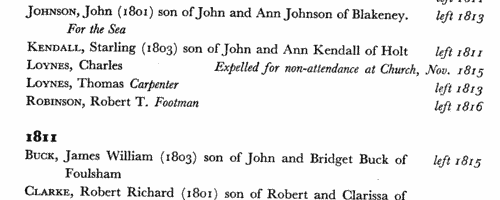
|  London Metropolitan Police
(1902-1911) London Metropolitan Police
(1902-1911)
The London Metropolitan Police Register of Joiners (MEPO 4/337) lists policemen joining the force 14 July 1902 to 10 April 1911 (warrant numbers 88812 to 100006). The register is alphabetical, in so far as the recruits are listed chronologically grouped under first letters of surname. It gives Date of Appointment, Name, Number of Warrant, Cause of Removal from Force (resigned, dismissed, promoted or died), and Date of Removal. The information about removal is sometimes wanting. A final column of 'Remarks' is largely blank, but occasionally gives an alias or a cross-reference to another warrant number. The register is discoloured and damaged in places, and one or two pages are missing.LARK. Cost: £8.00.  | Sample scan, click to enlarge

| Military Medal for Bravery in the Field
(1916)
King George V awarded the Military Medal for bravery in the field to these Non-Commissioned Officers and Men 11 November 1916.LARK. Cost: £4.00.  | Sample scan, click to enlarge
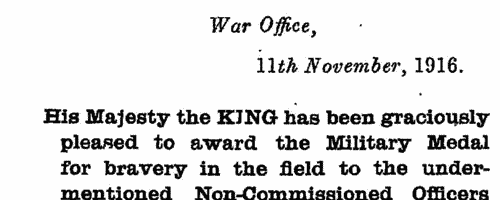
| Naturalizations
(1917)
The Home Office issued monthly lists of aliens to whom Certificates of Naturalization or Readmission to British Nationality had been granted by the Secretary of State and whose oaths of allegiance had been registered in the Home Office. These notices, from January to December 1917, refer to naturalizations from December 1916 to November 1917. The lists give full name, surname first; country of origin; date of taking the oath of allegiance; place of residence; and occupation. An dagger indicates re-admission to British nationality.LARK. Cost: £6.00.  | Sample scan, click to enlarge

| The Royal Navy List or Who's Who in the Navy
(1917)
Services, honours and special qualifications of officers (active and retired) of the Royal Navy, Royal Indian Marine, Royal Naval Reserve, the dominion navies and the Royal Marines
LARK. Cost: £4.00.  | Sample scan, click to enlarge
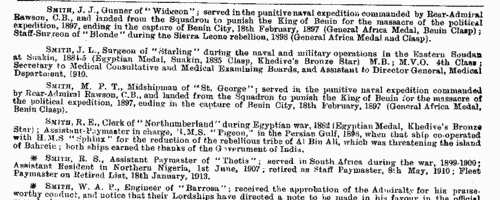
| Students of the Trinity College of Music
(1929)
The Calendar of the Trinity College of Music, London, for the year 1929 includes lists of licentiates and associates, and then this list of current students. Surnames and initials are given; but women are distinguished by having their (first) christian name stated. The college provided instruction to nearly 1000 students a year, with examinations of 66,000 candidates a year at 700 local centres throughout the world. LARK. Cost: £4.00.  | Sample scan, click to enlarge
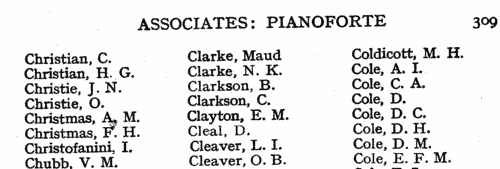
| Boys at University College School
(1901-1931)
In 1830 a school was set up adjoining the University and College of London on Gower Street; the school was enlarged from 1860 to 1876, and then removed to Frognal in 1907. In 1931 this register was published, listing all boys entering the school from Christmas term of 1859 to the summer entrants of 1931. The dates are abbreviated (98-01 = 1898-1901, &c.), each session being reckoned as beginning in September of one year and ending in the July of the next; the date of joining the school is indicated by the former, although it may fall in the latter, but the date of leaving by the latter, although it may fall in the former. Thus, if a boy came at any time during the Session 1863-64 and left any time during 1868-69, his date would be given 1863-69. The boys are listed alphabetically by surname, and then chronologically under each surname, full name being given where known. An asterisk * indicates that that particular boy lost his life in the Great War: in these cases, rank and regiment have been given where possible. Addresses as of 1931 are given where known. Italics in christian names or initials indicate that that particular boy was known, in 1931, to be dead. (a) (b) &c placed before christian names indicates brothers. In some cases occupation in later life is shown (A, artist; B, barrister; C A, chartered accountant; Ch, chemist; E, engineer; H C S, home civil service; I C S, Indian civil service; Med, physician or surgeon; M S E, member of the Stock Exchange; Mus, musician; Rev, minister of religion; S, solicitor). This is the index to those boys who were at the school in the period 1901 to 1931.LARK. Cost: £4.00.  | Sample scan, click to enlarge

|
Research your ancestry, family history, genealogy and one-name study by direct access to original records and archives indexed by surname.
|













